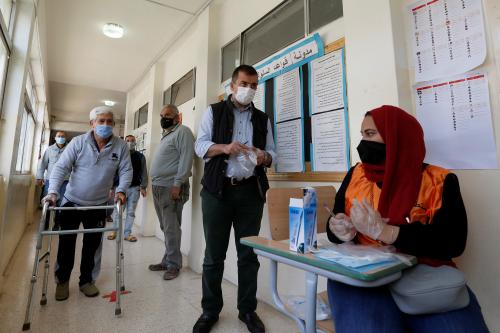Content from the Brookings Doha Center is now archived. In September 2021, after 14 years of impactful partnership, Brookings and the Brookings Doha Center announced that they were ending their affiliation. The Brookings Doha Center is now the Middle East Council on Global Affairs, a separate public policy institution based in Qatar.
On January 24, 2018, Turkish President Recep Tayyip Erdogan and U.S. President Donald Trump held a phone conversation. The timing of this call was sensitive because it came after Turkey’s military operation into Afrin–an area in northwestern Syria controlled by the Syrian Kurdish People’s Protection Units (YPG), an affiliate of Turkey’s outlawed Kurdistan Worker Party (PKK).
Two presidents of NATO-member states having a phone call is not unusual, but what happened afterward was. The White House released the transcript of the conversation, which asserted that Trump had expressed concern over escalating violence due to Turkey’s Afrin operation and about “destructive and false rhetoric coming from Turkey.” Turkish officials immediately claimed that the transcript did not reflect the true nature of the conversation. This short-lived row over the content of a phone call reflects the current state of U.S.–Turkish relations, which are characterized by disagreements, disputes, and miscommunication.
While miscommunication plays a part in this dispute, the source of the strategic divergence between the United States and Turkey cannot be reduced to political discourse or miscommunication. The current tension is present on several levels: personal, institutional, and geopolitical. Nowhere are these sources of tension reflected more clearly than within the context of the Syrian civil war. Besides significantly shaping Turkey’s domestic political context, this imbroglio has left an imprint on Turkey’s regional and international alliance structure.
During the course of the Syrian crisis, both Turkish–U.S. and Turkish–Russian relations have both experienced moments of close cooperation, coupled with major ruptures. In November 2015, after Turkey shot down a Russian jet, the level of enmity and of bellicose discourse between the two countries skyrocketed. But things have taken a dramatic turn since.
While Turkish–Russian relations have been on the mend since the second half of 2016—and carefully cooperative within the Syrian context—Turkish–U.S. relations have followed an opposite trajectory. The accumulation of new problems, on top of old simmering tensions have poisoned bilateral relations.
Given the centrality of Syria in the Turkish–U.S. context, it is essential to have a larger view of the evolution of the Syrian crisis and its implications for bilateral Turkish–American relations.
During the initial phase of the Arab uprisings, Turkey’s major complaint vis-à-vis the United States was its perceived indecisiveness and inaction regarding regime change in Syria. Yet, in recent years, U.S. policy toward the YPG within the framework of the war on ISIS, became the main stumbling block. In fact, the Syrian crisis and the fight against ISIS has shown that there is a growing gap between Turkish and U.S. threat perceptions and their formulas to deal with them. For example, Turkey regarded U.S. assistance to the YPG as tantamount to its indifference to Turkish security. With the breaking of the ISIS-imposed siege of the Syrian-Kurdish town of Kobane in early 2015, in which U.S. air support proved vital, the YPG has increasingly become the U.S.’s primary local partner on the ground in the fight against ISIS. The United States gradually shifted its focus and resources from the Syrian opposition groups to the PYD-YPG, which later morphed into the Syrian Democratic Forces (SDF) with the addition of Arab forces east of the Euphrates and in Manbij.
U.S. assistance to the SDF and YPG caused much concern in Turkey. Turkey’s sense of concern heightened further after the collapse of the domestic Kurdish peace process in Turkey in the second half of 2015, which led to a re-securitization of the Kurdish issue by Turkey, both domestically and regionally. Given the links between the PKK and the YPG, the crumbling of the peace process in Turkey immediately shaped Turkey’s perception of the YPG.
Despite Turkey’s heightened unease at this stage, it still did not completely give up on the United States in Syria. In particular, Turkey was among the few countries that warmly received the election of Donald Trump. It portrayed most of the frictions in bilateral relations, especially the ones generated by the Syrian civil war, as an outcome of Obama’s ineffective Syrian policy. With such a portrayal of the troubles in the relations, Turkey hoped that it could turn a new page with Trump administration, which later proved to be illusory, as Trump has more or less maintained the general contours of Obama’s Syria policy. Therefore, while Turkey was alarmed by improving U.S. relations with the YPG between 2015-2017, it still anticipated or hoped that once ISIS was defeated—at least in its territorial form—in Syria and Iraq, the utility of the Kurds for the U.S. would lessen, and with it, the U.S. commitment to the Kurds.
The fact that the U.S. has maintained and further deepened its alliance with the SDF, the post-ISIS period has dispelled any expectation in Ankara for a shift of U.S. policy concerning the Syrian Kurds. Ankara perceives this as the U.S and Syrian-Kurdish partnership evolving into the form of a more strategic and durable partnership, and hence moving beyond the depiction of these relations as merely an outcome of a marriage of convenience. In this respect, Turkey sees the United States’s recent open-ended commitment to maintain a military force in Syria and desire to create a 30,000 strong border force—most of which is projected to come from Kurdish YPG members.
These developments motivated Turkey to explore other options, particularly with Russia, rather than trying to convince the United States to cut ties with the Syrian Kurds. Turkey’s ongoing Afrin operation is a case in point. The triangle of Russian–Turkish–U.S. relations seems to have defined the character, nature, and arguably, the scope of the Afrin operation. While it was partially Turkish dismay with the U.S. policy of collaborating with the Kurdish-dominated SDF that drove Turkey to work more closely with Russia, it would be Russian policy that would broadly define the boundaries and nature of Turkey’s Afrin operation.
At present, both Turkey and Russia mutually benefit from cooperation in Syria. As Turkey needed Russian acquiescence for its Syrian operations—Euphrates Shield and Olive Branch in Afrin—Russia needs to keep Turkey close to maintain its course in Syria. The danger for Turkey, however, is that its over-reliance on Russia will reduce its capacity for strategic autonomy in its foreign policy, but particularly in Syria. Russia is not only increasingly becoming Turkey’s northern neighbor, but also its southern (due to its presence in Syria and Libya) and eastern neighbor (due to its presence in former Soviet Republics, particularly in Armenia). This will pose a strategic threat to Turkey in the mid-to-long term.
Last but not the least, despite the growing number of disputes in Turkish-U.S. relations, the lack of a functioning problem-solving mechanism between these countries has further aggravated relations. To make matters worse, the institutional ownership of elite constituency of Turkish–U.S. relations in both countries has significantly weakened. The combined impact of all of these factors is that we should brace ourselves for a further deterioration of Turkish-U.S. relations.




Commentary
Op-edA difference of opinion? Fissures in US-Turkish relations after Syria
January 26, 2018